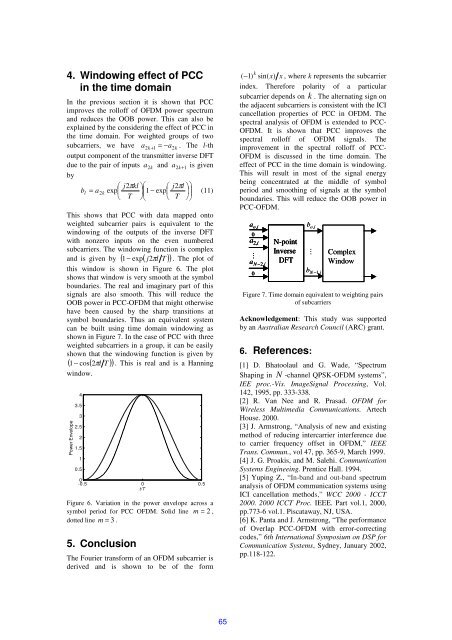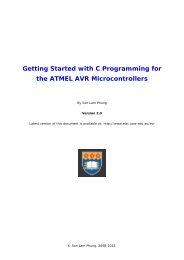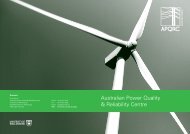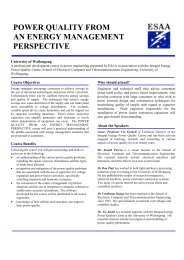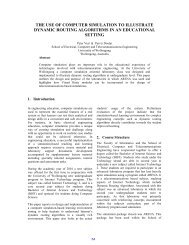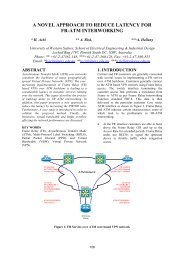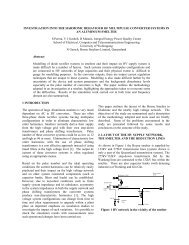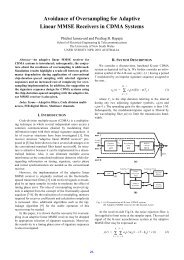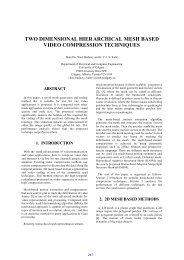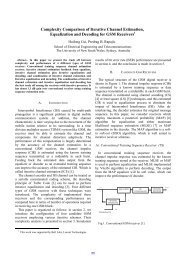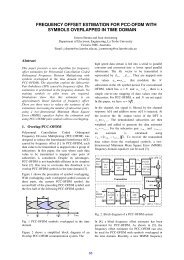Spectral Analysis of OFDM Signals and its Improvement by Polynomial
Spectral Analysis of OFDM Signals and its Improvement by Polynomial
Spectral Analysis of OFDM Signals and its Improvement by Polynomial
- No tags were found...
You also want an ePaper? Increase the reach of your titles
YUMPU automatically turns print PDFs into web optimized ePapers that Google loves.
4. Windowing effect <strong>of</strong> PCCin the time domainIn the previous section it is shown that PCCimproves the roll<strong>of</strong>f <strong>of</strong> <strong>OFDM</strong> power spectrum<strong>and</strong> reduces the OOB power. This can also beexplained <strong>by</strong> the considering the effect <strong>of</strong> PCC inthe time domain. For weighted groups <strong>of</strong> twosubcarriers, we have a2k+ 1 = −a2k. The l-thoutput component <strong>of</strong> the transmitter inverse DFTdue to the pair <strong>of</strong> inputs a 2 k <strong>and</strong> a2 k+1 is given<strong>by</strong> j2πkl j2πlbl= a2 k exp1− exp T T (11)This shows that PCC with data mapped ontoweighted subcarrier pairs is equivalent to thewindowing <strong>of</strong> the outputs <strong>of</strong> the inverse DFTwith nonzero inputs on the even numberedsubcarriers. The windowing function is complex<strong>and</strong> is given <strong>by</strong> ( 1− exp( j2πlT )). The plot <strong>of</strong>this window is shown in Figure 6. The plotshows that window is very smooth at the symbolboundaries. The real <strong>and</strong> imaginary part <strong>of</strong> thissignals are also smooth. This will reduce theOOB power in PCC-<strong>OFDM</strong> that might otherwisehave been caused <strong>by</strong> the sharp transitions atsymbol boundaries. Thus an equivalent systemcan be built using time domain windowing asshown in Figure 7. In the case <strong>of</strong> PCC with threeweighted subcarriers in a group, it can be easilyshown that the windowing function is given <strong>by</strong>( 1 − cos( 2πl T )). This is real <strong>and</strong> is a Hanningwindow.Power Envelope43.532.521.510.50-0.5 0 0.5t/TFigure 6. Variation in the power envelope across asymbol period for PCC <strong>OFDM</strong>. Solid line m = 2 ,dotted line m = 3 .5. ConclusionThe Fourier transform <strong>of</strong> an <strong>OFDM</strong> subcarrier isderived <strong>and</strong> is shown to be <strong>of</strong> the formk(− 1) sin( x)x , where k represents the subcarrierindex. Therefore polarity <strong>of</strong> a particularsubcarrier depends on k . The alternating sign onthe adjacent subcarriers is consistent with the ICIcancellation properties <strong>of</strong> PCC in <strong>OFDM</strong>. Thespectral analysis <strong>of</strong> <strong>OFDM</strong> is extended to PCC-<strong>OFDM</strong>. It is shown that PCC improves thespectral roll<strong>of</strong>f <strong>of</strong> <strong>OFDM</strong> signals. Theimprovement in the spectral roll<strong>of</strong>f <strong>of</strong> PCC-<strong>OFDM</strong> is discussed in the time domain. Theeffect <strong>of</strong> PCC in the time domain is windowing.This will result in most <strong>of</strong> the signal energybeing concentrated at the middle <strong>of</strong> symbolperiod <strong>and</strong> smoothing <strong>of</strong> signals at the symbolboundaries. This will reduce the OOB power inPCC-<strong>OFDM</strong>.a o, i0a 2 ,ia N−2,i0N-pointInverseDFTb o,iFigure 7. Time domain equivalent to weighting pairs<strong>of</strong> subcarriersAcknowledgement: This study was supported<strong>by</strong> an Australian Research Council (ARC) grant.6. References:b N−1,iComplexWindow[1] D. Bhatoolaul <strong>and</strong> G. Wade, “SpectrumShaping in N -channel QPSK-<strong>OFDM</strong> systems”,IEE proc.-Vis. ImageSignal Processing, Vol.142, 1995, pp. 333-338.[2] R. Van Nee <strong>and</strong> R. Prasad. <strong>OFDM</strong> forWireless Multimedia Communications. ArtechHouse. 2000.[3] J. Armstrong, “<strong>Analysis</strong> <strong>of</strong> new <strong>and</strong> existingmethod <strong>of</strong> reducing intercarrier interference dueto carrier frequency <strong>of</strong>fset in <strong>OFDM</strong>,” IEEETrans. Commun., vol 47, pp. 365-9, March 1999.[4] J. G. Proakis, <strong>and</strong> M. Salehi. CommunicationSystems Engineeing. Prentice Hall. 1994.[5] Yuping Z., “In-b<strong>and</strong> <strong>and</strong> out-b<strong>and</strong> spectrumanalysis <strong>of</strong> <strong>OFDM</strong> communication systems usingICI cancellation methods,” WCC 2000 - ICCT2000. 2000 ICCT Proc. IEEE. Part vol.1, 2000,pp.773-6 vol.1. Piscataway, NJ, USA.[6] K. Panta <strong>and</strong> J. Armstrong, “The performance<strong>of</strong> Overlap PCC-<strong>OFDM</strong> with error-correctingcodes,” 6th International Symposium on DSP forCommunication Systems, Sydney, January 2002,pp.118-122.


